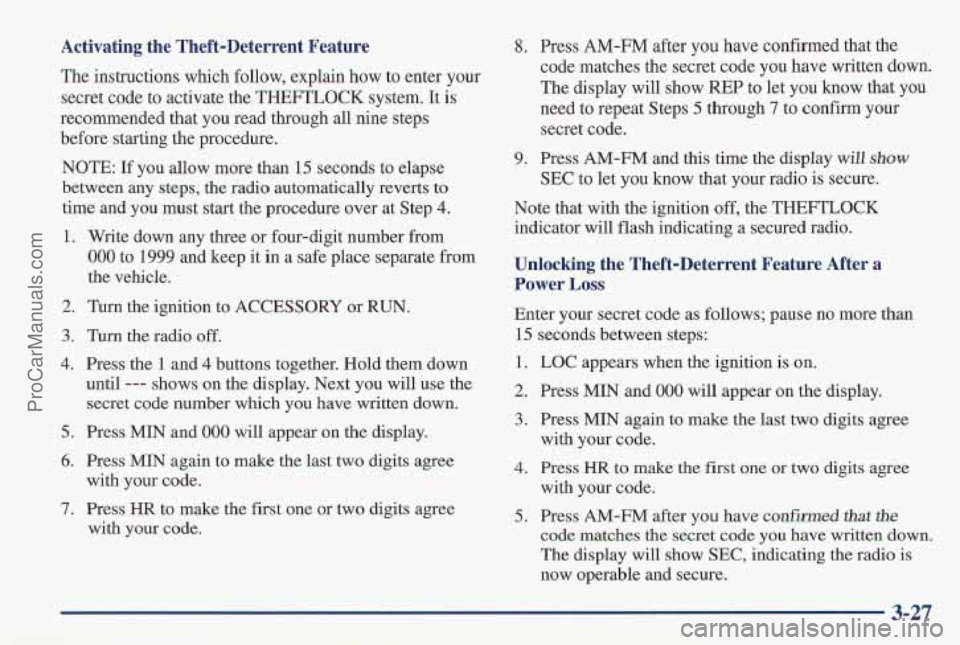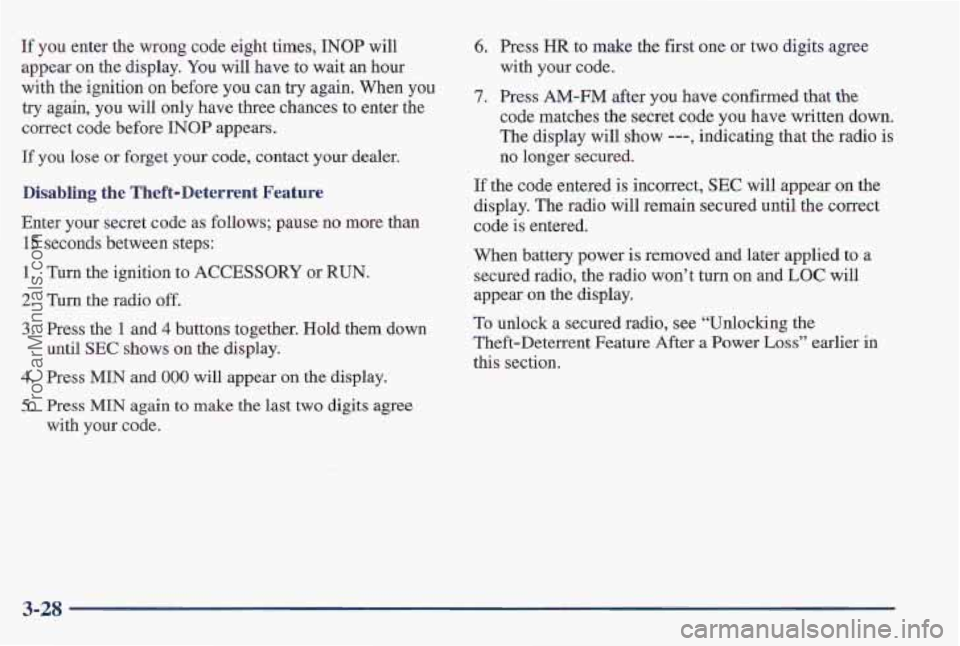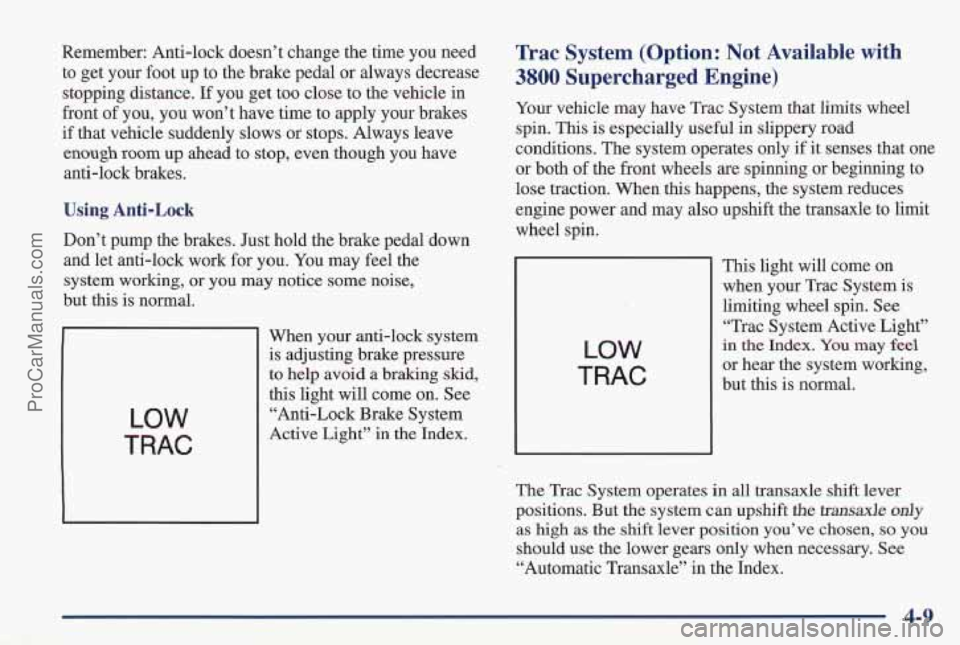1997 PONTIAC PONTIAC lock
[x] Cancel search: lockPage 187 of 419

Activating the Theft-Deterrent Feature
The instructions which follow, explain how to enter your
secret code to activate the THEFTLOCK system. It
is
recommended that you read through all nine steps
before starting the Drocedure.
8. Press AM-FM after you have confirmed that the
code matches the secret code you have written down.
The display will show
REP to let you know that you
need to repeat Steps 5 through
7 to confirm your
secret code.
w I
NOTE: If you allow more than 15 seconds to elapse 9. Press AM-FM and this time the display will show
between any steps, the radio automatically reverts to SEC
to let you know that your radio is secure.
time and you must start the procedure over at Step
4. Note that with the ignition off, the THEFTLOCK
1.
2.
3.
4.
5.
6.
7.
-
Write down any three or four-digit number from
000 to 1999 and keep it in a safe place separate from
the vehicle.
Turn the ignition to ACCESSORY or
RUN.
Turn the radio off.
Press the 1 and 4 buttons together. Hold them down
until
--- shows on the display. Next you will use the
secret code number which you have written down.
Press MIN and
000 will appear on the display.
Press MIN again to make the last two digits agree
with your code.
Press
HR to make the first one or two digits agree
with your code. indicator will flash
indicating a secured radio.
Unlocking the Theft-Deterrent Feature After a
Power
Loss
Enter your secret code as follows; pause no more than
15 seconds between steps:
1. LOC appears when the ignition is on.
2. Press MIN and 000 will appear on the display.
3. Press MIN again to make the last two digits agree
4. Press HR to make the first one or two digits agree
5. Press AM-FM after you have confirmed that the
with your code.
with your code.
code matches the secret code you have written down.
The display will show SEC, indicating the radio is
now operable and secure.
ProCarManuals.com
Page 188 of 419

If you enter the wrong code eight times, INOP will
appear
on the display. You will have to wait an hour
with the ignition on before you can try again. When you
try again, you
will only have thee chances to enter the
correct code before
INOP appears.
If you lose or forget your code, contact your dealer.
Disabling the Theft-Deterrent Feature
Enter your secret code as follows; pause no more than
15 seconds between steps:
1. Turn the ignition to ACCESSORY or RUN.
2. Turn the radio off.
3. Press the 1 and 4 buttons together. Hold hem down
until
SEC shows on the display.
4. Press MIN and 000 will appear on the display.
5. Press MIN again to make the last two digits agree
with your code.
6. Press HR to make the first one or two digits agree
with your code.
7. Press AM-EM after you have confirmed that the
code matches the secret code you have written down.
The display will
show ---, indicating that the radio is
no longer secured.
If the code entered is incorrect, SEC will appear on the
display. The radio will remain secured until the correct
code is entered.
When battery power is removed and later applied to a
secured radio,
the radio won’t turn on and LOC will
appear
on the display.
To unlock a secured radio, see “Unlo’cking the
Theft-Deterrent Feature After
a Power Loss” earlier in
this section.
3-28
ProCarManuals.com
Page 195 of 419

I
Section 4 Your Driving and the Road
Here you’ll find information about driving on different kinds of roads and in varying weather conditions. We’ve also
included many other useful tips on driving.
4-2
4-3
4-6
4-6
4-7
4-9
4-11
4-11
4-13
4-13 Defensive
Driving
Driving Drunk
Having Control
of Your Vehicle
Your Braking System Information
Anti-Lock Brake Information
Trac System
Braking in Emergencies
Steering Tips
Off-Road
Recovery Tips
Passing Other Vehicles 4-
15
4-16
4-
17
4-22 4-23
4-23 4-25
4-27
4-29
4-3 1
Losing Control of Your Vehicle
Night Driving
Driving in Rain and on Wet Roads
Tips Before Leaving on a Long Trip
Avoiding Highway Hypnosis
Driving on Hills and Mountains
Winter Driving
If You’re Caught in
a Blizzard
Loading
Your Vehicle
Helpful Hints for Towing a Trailer
4-1
.- ;.. i .,;,;.L. ._ r _- , . .. - .. .. ProCarManuals.com
Page 201 of 419

Avoid needless heavy braking. Some people drive in
spurts
-- heavy acceleration followed by heavy
braking
-- rather than keeping pace with traffic. This is a
mistake. Your brakes may not have time to cool between
hard stops. Your brakes will wear out much faster if you
do a lot of heavy braking. If you keep pace with the
traffic and allow realistic following distances, you will
eliminate a lot of unnecessary braking. That means
better braking and longer brake life.
If
your engine ever stops while you’re driving, brake
normally but don’t pump your brakes.
If you do, the
pedal may get harder to push down.
If your engine
stops, you will still have some power brake assist. But
you
will use it when you brake. Once the power assist is
used up, it may take longer to stop and the brake pedal
will be harder to push.
Anti-Lock Brakes (ABS)
Your vehicle has anti-lock brakes (ABS). ABS is an
advanced electronic braking system that will help
prevent a braking skid.
When you start your engine, or when you
begin to drive
away, your anti-lock brake system will check itself. You
may hear a momentary motor or clicking noise while
this test is going on, and you may even notice that your
brake pedal moves a little. This is normal.
If there’s a problem with the
anti-lock brake system, this
warning light will stay on or
flash. See “Anti-Lock
Brake System Warning
Light” in the Index.
4-7
ProCarManuals.com
Page 202 of 419

Here’s how anti-lock works. Let’s say the road is wet.
You’re driving safely. Suddenly an animal jumps out
in
front of you.
You slam
on the brakes. Here’s what happens with ABS.
A computer senses that wheels are slowing down. If one
of the wheels is about to stop rolling, the computer will
separately work the brakes at each front wheel and at the
rear wheels. The
anti-lock system can change the brake pressure
faster than any driver could. The computer is
programmed to make the most of available tire and
road conditions.
You can steer around the obstacle while braking hard.
As you brake, your computer keeps receiving updates on
wheel speed and controls braking pressure accordingly.
4-8
ProCarManuals.com
Page 203 of 419

Remember: Anti-lock doesn’t change the time you need
to get your foot up to the brake pedal or always decrease
stopping distance. If you get too close to the vehicle in
front of you, you won’t have time to apply your brakes
if that vehicle suddenly slows or stops. Always leave
enough room up ahead to stop, even though you have
anti-lock brakes.
Using Anti-Lock
Don’t pump the brakes. Just hold the brake pedal down
and let anti-lock work for you. You may feel the
system working, or you may notice some noise,
but this is normal.
LOW
TRAC
When your anti-lock system
is adjusting brake pressure
to help
avoid a braking skid,
this light will come on. See
“Anti-Lock Brake System
Active Light” in the Index.
Trac System (Option: Not Available with
3800 Supercharged Engine)
Your vehicle may have Trac System that limits wheel
spin. This
is especially useful in slippery road
conditions. The system operates only if it senses that one
or both of the front wheels are spinning or beginning to
lose traction. When this happens, the system reduces
engine power and may also upshift the transaxle to limit
wheel spin.
LOW
TRAC
This light will come on
when your Trac System is
limiting wheel spin. See
“Trac System Active Light”
in
the Index. You may feel
or hear the system working,
but this is normal.
The Trac System operates in all transaxle shift lever
positions. But the system can upshift
the tran.saxle only
as high as the shift lever position you’ve chosen, so you
should use the lower gears only when necessary. See
“Automatic Transaxle” in the Index.
4-9
ProCarManuals.com
Page 205 of 419

Braking in Emergencies
With anti-lock, you can steer and brake at the same
time. In many emergencies, steering can help you more
than even the very best braking.
Steering
Power Steering
If you lose power steering assist because the engine
stops or the system is not functioning, you can steer but
it will take much more effort.
Variable Effort Steering (Option)
This steering system provides lighter steering effort
for parking and when driving at speeds below
20 mph
(32 km/h). Steering effort will increase at higher speeds
for improved road
feel.
Steering Tips
Driving on Curves
It’s important to take curves at a reasonable speed.
A lot of the “driver lost control” accidents mentioned on
the news happen
on curves. Here’s why: Experienced
driver or beginner, each of us is subject to
the same laws
of physics when driving on curves. The
traction of the tires against the road surface makes it
possible for the vehicle to change its path when you turn
the front wheels. If there’s no traction, inertia will keep
the vehicle going in the same direction.
If you’ve eva
tried to steer a vehicle on wet ice, you’ll understand this.
The traction you can get in
a curve depends on the .
condition of your tires and the road surface, the angle at
which
the curve is banked, and your speed. While you’re
in
a curve, speed is the one factor you can control.
Suppose you’re steering through a sharp curve. Then
you suddenly accelerate. Both control systems
--
steering and acceleration -- have to do their work where
the tires meet the road. Unless you have the Trac System
and the system is on, adding
the sudden acceleration can
demand too much
of those places. You can lose control.
Refer to “Trac System” in the Index.
What should you do if this ever happens? Ease up on the
accelerator pedal, steer the vehicle the way you want it
to
go, and slow down.
Speed limit signs near curves warn that you should
adjust your speed.
Of course, the posted speeds are
based on good weather and road conditions. Under less
favorable conditions you’ll want to go slower.
ProCarManuals.com
Page 206 of 419

If you need to reduce your speed as you approach a
curve, do it before you enter the curve, while your front
wheels are straight ahead.
Try to adjust your speed
so you can “drive” through the
curve. Maintain a reasonable, steady speed. Wait to
accelerate until you are out of the curve, and then
accelerate gently into
the straightaway.
Steering in Emergencies
There are times when steering can be more effective
than braking, For example, you come over a hill and
find a truck stopped in your lane, or a car suddenly pulls
out from nowhere, or a child darts out from betw,een
parked cars and stops right in front
of you. You can
avoid these problems by braking
-- if you can stop
in time. But sometimes you can’t; there isn’t room.
That’s the time for evasive action
-- steering around
the problem.
Your Pontiac can perform very well in emergencies like
these. First apply
your brakes. (See “Braking in
Emergencies” earlier in
this section.) It is better to
remove as much speed as you can from a possible
collision. Then steer around
the problem, to the left or
right depending
on the space available.
An emergency like this requires close attention and a
quick decision.
If you are holding the steering wheel at
the recommended 9 and 3 o’clock positions, you can
turn
it a full 180 degrees very quickly without removing
either hand. But you have to act fast, steer quickly, and
just as quickly straighten the wheel once you have
avoided the object.
The fact that such emergency situations are always
possible
is a good reason to practice defensive driving at
all times
and wear safety belts properly.
4-12
ProCarManuals.com